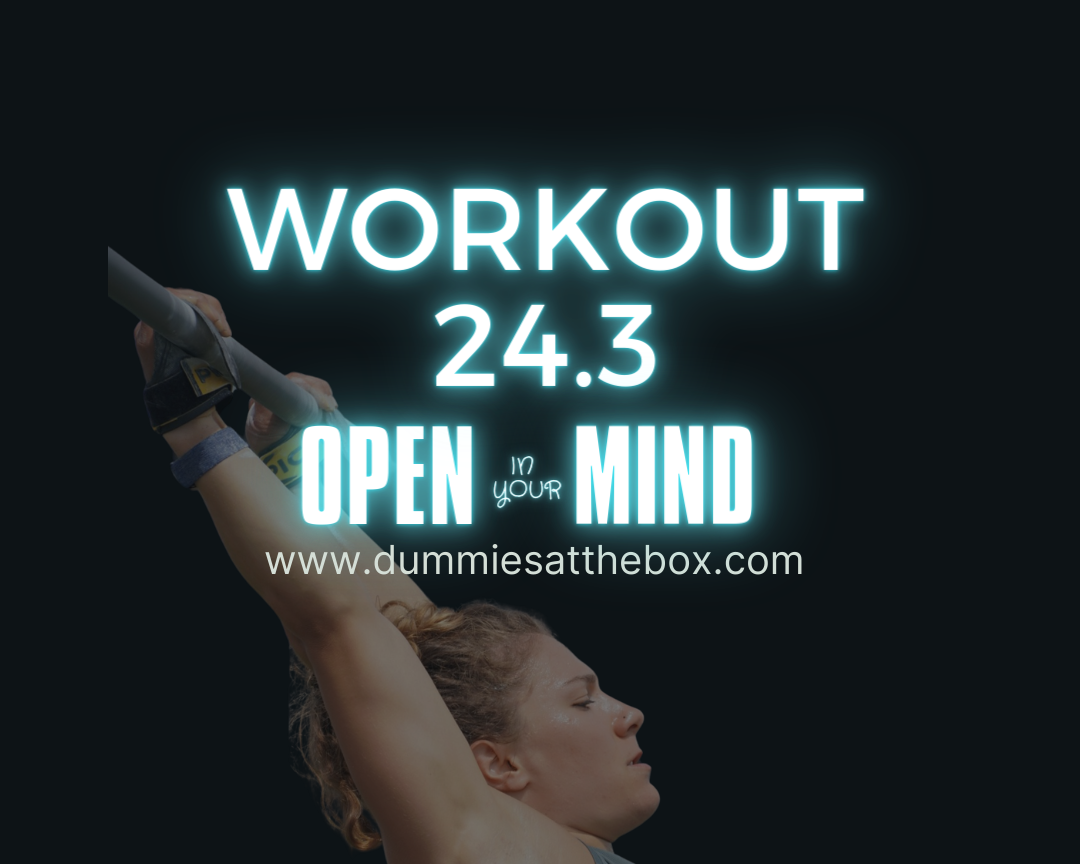Here we are, Open workout 24.2 is out! Let’s start with this guide for your right mindest
Entering the final stretch of this year’s CrossFit Open, we’re met with a workout that promises to test skill, stamina and nervous system.
After two not-so-technical workouts (no, we’re not underplaying double unders), finally, some high technical gymnastics and weightlifting are in play! A blessing for some, a nightmare for others.
Besides the physical complexities of these skills, a big challenge lays in the neural impact of the weight and the gymnastics. You want to pace correctly, minimize (as much as possible) your neural, grip, and muscular fatigue, and remain focused.
This is the classic kind of WOD where you need to consider one main thing: your ego. Ditch it!
Although this is a good practice for any workout, it is definitely fundamental in this one. If the first section resembles Fran and you may be tempted to go all-out (or, anyway, quite hot), keep in mind that the second part steps up the game with a higher gymnastics’ skill and heavier weight on the barbell.
If you rush through the C2B, you might compromise your grip, which may possibly lead to failure in the BMU, have you all tangled up with fear and frustration while trying (much like tripping on DU in the previous WOD) and fatigue your central nervous system, resulting in delayed reaction time and impaired motor control, which will reduce even more accuracy and efficiency.
If you push too hard on those light-ish thrusters, aside from cardiovascular strain and muscle fatigue, you could experience brain fog due to inadequate oxygenation to your brain (if you made this mistake in 24.1, I’m sure you don’t want to repeat it).
Lastly, if (like many) you’re one of those athletes particularly skilled at either the barbell or the pull-up bar, going particularly hard or unbroken in the movement you excel at (be it thrusters or C2B/BMU) could seriously compromise the movement where you’re less proficient.
So, although we know you may be tempted to speed up in the first section, you risk this may come back to haunt you later.
A minute of rest is minimal so, for the love of God, do not go all out too hot! No worries, there are strategies to prevent and manage everything.
As usual, looking into tips from reliable sources, discussing strategies with your coaches, and creating a plan tailored to you will be crucial.
That said, many tools discussed in the previous two articles apply here (you should really check those out!), such as grounding, box breathing, and mindfulness, both to deal with BMU failure, fatigue management and pace maintenance.
Tools for your 24.3
Besides these, here are some new tools that could also be helpful for this WOD:
- Motor Schemes Reinforcement: Mentally rehearsing movements, known as motor imagery, and physically reinforcing motor schemes, can strengthen neural pathways, improving movement execution and efficiency. Depending on your confidence level/efficiency with C2B/BMU, you may want to practice some motor imagery beforehand and stick to kipping chest to bar in the first section rather than butterfly. This is because it will be beneficial to reinforce a motor scheme that you will also use afterward for your BMU, rather than using a completely different one.
- Metacognitive Strategies: If the initial segment seems relatively straightforward, we understand the temptation to abandon the original plan and accelerate transitions. For once, instead of fixating on your current sensations during the WOD, redirect your mental focus towards the desired outcome you’ve planned for. Have a chat with yourself and reflect on the long-term consequences of an inadequately paced workout. You’ll thank yourself later!
- Adaptive Mindset: Embrace setbacks during the first section as opportunities for growth rather than failures, and preserve mental energy and resilience for the second section. Don’t let the frustration sets in: make the most of that 1-minute rest period by strolling around, taking deep breaths, and reminding yourself your plan. You’ve got this.
As usual, after the WOD, breathe, spend time with your community, refill your tank and reflect. This time, prompts could be: “Was your plan effective? If not, why? Were you able to stick to it? If not, why? Did your ego get the best out of you? Did you set unrealistic expectations for yourself? Did you struggle with a specific movement, weight, or stamina? Did your transitions go as planned? How was your mind doing? How did you manage any setbacks? Are you satisfied with your performance? What adjustments are necessary to address any challenges? What support is required to address these adjustments? Who is best person to help you with that?”
To sum up:
Before the WOD:
- Dive into technical tips and insights from top-notch coaches.
- Develop YOUR plan tailored to YOUR abilities.
- Start with a solid warm-up to prep both mind and body + Motor Imagery.
During the WOD:
- Grounding, Box Breathing & Mindfulness to manage setbacks and frustration (look back to 24.1 & 24.2’s posts)!
- Motor Schemes Reinforcement to maximise accuracy and efficiency.
- Metacognitive Strategies to remind yourself to stick to your plan.
- Adaptive Mindset to make the most out of that 1 minute break.
- Have fun!!!
After the WOD:
- Breathe!
- Community & Food.
- Reflections/ Takeaways/ Plan.
Italian version
Giungendo alla fase finale del CrossFit Open di quest’anno, ci troviamo di fronte ad un WOD che promette di mettere alla prova abilità, resistenza e sistema nervoso.
Dopo due WOD non altamente tecnici (no, non stiamo sottovalutando i double unders), finalmente entrano in gioco esercizi di ginnastica e di bilanciere più complessi!
Una benedizione per alcuni, un incubo per altri.
Oltre alle difficoltà fisiche di queste skills, una grande sfida risiede nell’impatto neurale del peso e della ginnastica. È fondamentale regolare il pace correttamente, minimizzare (quanto possibile) la fatica neurale, di presa e muscolare e rimanere concentrati.
Questo è il classico WOD in cui devi considerare una cosa principale: il tuo ego. Lascialo da parte!
Anche se questa è una buona pratica per qualsiasi workout, è sicuramente fondamentale in questo caso.
Se la prima sezione assomiglia a Fran e potresti essere tentato di dare tutto (o comunque, andare piuttosto forte), ricorda che la seconda parte rilancia il livello con una skill di ginnastica più complessa ed un peso più pesante sul bilanciere.
Se vai troppo veloce con i C2B, rischi di compromettere la tua presa, cosa che poi potrebbe portarti a fallire i BMU, lasciarti ingarbugliato tra paura e frustrazione mentre ci provi (molto simile ad inciampare nei DU nel WOD precedente) ed affaticare il tuo sistema nervoso centrale, con conseguente ritardo nei tempi di reazione, compromissione del controllo motorio, e riduzione di accuratezza ed efficienza dei movimenti.
Se spingi troppo forte su quei thrusters relativamente leggeri, oltre all’affaticamento cardiovascolare e muscolare, potresti sperimentare confusione mentale a causa di un’ossigenazione inadeguata al tuo cervello (se hai fatto questo errore nel 24.1, siamo sicuri che non vuoi ripeterlo).
Per finire, se (come molti) sei uno di quegli atleti particolarmente bravi al bilanciere o alla sbarra, andare particolarmente forte o unbroken nel movimento che ti riesce meglio (siano i thrusters o i C2B/BMU) potrebbe seriamente compromettere il movimento dove riesci meno bene.
Quindi, anche se sappiamo che potresti essere tentato di andare veloce nella prima sezione, rischi che questo abbia un impatto molto negativo sulla seconda parte.
Un minuto di riposo è minimo, quindi, per amor di Dio, non andare troppo forte!
Niente paura, come sempre ci sono strategie per prevenire e gestire tutto.vCome detto in precedenza, un aspetto cruciale è cercare consigli da fonti affidabili, discutere strategie con i tuoi coach e creare un piano su misura per te.
Detto questo, molti strumenti discussi nei due articoli precedenti si applicano anche qui (dovresti davvero dargli una letta!), come grounding, box breathing e mindfulness, per affrontare il fallimento di BMU, la gestione della fatica ed il mantenimento del pace.
Oltre a questi, ecco alcuni nuovi strumenti che potrebbero essere utili per questo WOD:
- Rinforzo degli schemi motori: ripetere mentalmente i movimenti, noto come immaginazione motoria, e rafforzare fisicamente gli schemi motori, può rafforzare gli schemi neurali, migliorando l’esecuzione e l’efficienza del movimento. A seconda del tuo livello di efficienza con i C2B/BMU, potresti voler praticare un po’ di immaginazione motoria prima ed attenerti a kipping C2B nella prima sezione anziché al butterfly. Questo sarà vantaggioso per rafforzare uno schema motorio che utilizzerai anche dopo per i tuoi BMU, piuttosto che utilizzarne uno completamente diverso.
- Strategie metacognitive: visto che la parte iniziale sembra relativamente semplice, capiamo la tentazione di abbandonare il piano originale ed accelerare le transizioni. Per una volta, anziché fissarti sulle sensazioni che provi durante il WOD, ridirigi la tua attenzione mentale verso l’obiettivo che hai pianificato. Fai una chiacchierata con te e rifletti sulle conseguenze a lungo termine di un wod mal gestito. Ti ringrazierai dopo!
- Mentalità adattativa: guarda alle difficoltà incontrate nella prima sezione come opportunità di crescita piuttosto che fallimenti, e conserva energia mentale e resilienza per la seconda parte. Non lasciare che la frustrazione ti prenda: sfrutta al massimo quel minuto di pausa passeggiando, facendo respiri profondi e ricordandoti il tuo piano. Dai che ce la fai!
Come al solito, dopo il WOD, respira, trascorri del tempo con la tua community, ricarica le energie e rifletti. Questa volta, i suggerimenti potrebbero essere: “Il tuo piano è stato efficace? Se no, perché? Sei riuscito a seguirlo? Se no, perché? Il tuo ego ha avuto la meglio su di te? Avevi aspettative irrealistiche? Hai avuto difficoltà con un movimento, un peso o la endurance? Il pace è andato come previsto? Come stava la tua mente? Come hai gestito i fallimenti? Sei soddisfatto delle tue prestazioni? Quali cambiamenti sono necessari per affrontare eventuali problemi emersi? Quel è il miglior supporto/ persona per aiutarti con questo?”
Per riassumere,
Prima del WOD:
– Informati sui consigli tecnici da fonti affidabili e dai tuoi coach.
– Sviluppa IL TUO piano su misura per LE TUE abilità.
– Inizia con un riscaldamento solido per preparare sia mente che corpo + immaginazione motoria.
Durante il WOD:
– Grounding, Box Breathing & Mindfulness per gestire ostacoli e frustrazioni (guarda indietro ai post 24.1 e 24.2)!
– Rinforzo degli schemi motori per massimizzare accuratezza ed efficienza dei movimenti.
– Strategie metacognitive per ricordarti di attenerti al tuo piano.
– Mentalità adattativa per sfruttare al massimo quel minuto di pausa.
– Divertiti!!!
Dopo il WOD:
– Respira!
– Community & Cibo.
– Riflessioni/ Lezioni apprese/ Piano d’azione

